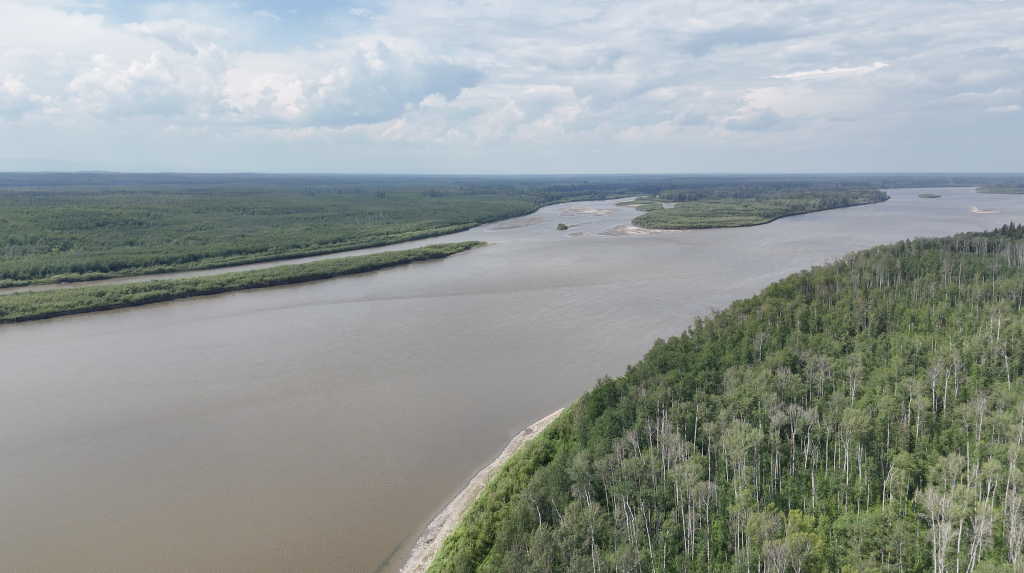The Context
ACFN is taking legal action following two toxic tailings spills from the Kearl Facility (operated by Imperial Oil Resources Limited) between May 2022 and February 2023. The accumulation of those spills, plus a third discharge of process-affected water in November 2023, resulted in over 5.3 million liters of tailings and 670,000 litres of other contaminated water released directly into ACFN territory — lands and waters central to their culture, Dene law, and Treaty rights. Despite knowing about the ongoing tailings discharges for nine months, the AER failed to notify ACFN or take adequate action to mitigate harm. It was only through public media circulation that ACFN learned about an Environmental Protection Order issued in response to the first two spills, months after they had occurred.
The discharges are not isolated incidents, but signs of systemic failure. AER’s ongoing inaction reflects deeper issues in Alberta’s regulatory system. The government has set up a system where decisions about approving industrial projects and consulting with First Nations are kept separate — despite these projects all taking place on Treaty lands and creating impacts that interact and may exacerbate each other. Further, there are unfair rules that limit which projects First Nations are allowed to give input on. These rules are written into laws, policies, and government orders, and they make it easy for major developments to move ahead without properly involving Indigenous communities, who are the most affected when things go wrong.
ACFN was excluded from decisions about tailings risks, denied consultation about threats to their lands and waters, and then actively excluded from being warned about when these risks came to fruition.
This case aims to expose how current policies sideline Indigenous Nations from critical environmental decision-making. These omissions violate Treaty rights and perpetuate environmental racism. ACFN’s legal action holds the AER accountable for its lack of consultation or consideration for how cumulative impacts affect ACFN’s Aboriginal and Treaty rights.
The Legal Case
Under the current system, no notice to or consultation with ACFN was required for tailings management decisions at the Kearl Facility after the initial permitting. After that, major decisions about tailings management at the Kearl Facility were not subject to consultation or any input from ACFN or other potentially affected First Nations. As a result of this, the AER provides no meaningful opportunity to ACFN to raise concerns about potential adverse impacts to ACFN’s rights arising from tailings management. Indeed, the AER’s decision-making and regulatory regime with respect to tailings management gives no consideration whatsoever to the rights or interests of ACFN, and its decisions are made in spite of, rather than with regard to, the rights and interests of ACFN. ACFN also argues that the AER breaches their Treaty rights through impacts on these rights through the AER’s negligent regulation of the Kearl Facility.
But ACFN isn’t only relying on s. 35 rights to hold AER to account, they are also bringing claims of negligence and nuisance, private law claims that, if successful, will help establish private law avenues for Indigenous Nations to seek redress for regulatory negligence.
Negligence arises when a duty of care is owed, in this case to ACFN, by the AER, to regulate Kearl in a safe and responsible manner, which does not cause harm to people or the environment. AER’s decisions in how to regulate the Facility, and particularly its decision not to warn ACFN of the discharges into the surrounding environment, fell significantly below the applicable standard of care, and the AER breached its duty to ACFN. Nuisance occurs when there is an adverse impact on an interest in land, such as the exercise of inherent and Treaty rights. In this case, the rights of ACFN which have been impacted by loss of use and enjoyment of lands, the ability to hunt, fish, and trap, and interference with cultural connection to those lands and waters.
Desired Outcomes
If successful, ACFN seeks the following outcomes:
- Against the Province of Alberta:
a. a declaration that the regulatory and policy framework for the authorization and regulation of tailings facilities is inconsistent with s. 35 of the Constitution Act, 1982, and unconstitutional, and of no force or effect to the extent of that inconsistency;
b. a declaration that the Province has unjustifiably infringed the ACFN’s Rights;
c. a declaration that the Province has caused, contributed to, and allowed the substantial diminution of ACFN’s traditional way of life;
d. a declaration that the Province has failed to discharge its honourable obligations under Treaty 8;
e. an order directing the Province to disgorge all or part of the royalties or equivalent payments received by it in relation to the Kearl Project during the time of the Uncontrolled Discharges, and to pay said royalties to ACFN;
f. general, special, punitive, and aggravated damages to the Plaintiffs for the Province’s breach of fiduciary duty, breach of the duty to consult, breach of the honour of the Crown, and treaty infringement, in an amount to be determined at trial;
g. an order that the Province take all reasonable and necessary steps to abate and remediate the Uncontrolled Discharges, and to prevent further Uncontrolled Discharges;
h. Costs of proceedings
- Against the AER:
a. general, special, punitive and aggravated damages to the Plaintiffs for the AER’s negligence, nuisance, breach of the duty to consult and breach of the honour of the Crown in an amount to be determined at trial;
b. a declaration that the AER breached the honour of the Crown and the duty to consult in its response to the Uncontrolled Discharges;
c. an order that the AER take all reasonable and necessary steps to abate and remediate the Uncontrolled Discharges, and to prevent further Uncontrolled Discharges;
d. costs of the proceedings.




